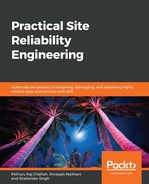We have understood the requirements and the challenges. The following sections describe how the SRE field is used to bridge the gap between supply and demand. As explained previously, building software applications through configuration, customization, and composition (orchestration and choreography) is progressing quickly. Speedier programming of software applications using agile programming methods is another incredible aspect of software building. The various DevOps tools from product and tool vendors quietly ensures continuous software integration, delivery, and deployment.
The business landscape is continuously evolving, and consequently the IT domain has to respond precisely and perfectly to the changing equations and expectations of the business houses. Businesses have to be extremely agile, adaptive, and reliable in their operations, offerings, and outputs. Business automation, acceleration, and augmentation are being solely provided by the various noteworthy improvements and improvisations in the IT domain.
IT agility and reliability directly guarantees the business agility and reliability. As seen previously, the goal of IT agility (software design, development, and deployment) is getting fulfilled through newer techniques. Nowadays, IT experts are looking out for ways and means for significantly enhancing IT reliability goals. Typically, IT reliability equals IT elasticity and resiliency. Let's us refer to the following bullets:
- IT elasticity: When an IT system is suddenly under a heavy load, how does the IT system provision and use additional IT resources to take care of extra loads without affecting users? IT systems are supposed to be highly elastic to be right and relevant for the future of businesses. Furthermore, not only IT systems but also the business applications and the IT platforms (development, deployment, integration, orchestration, brokerage, and so on) have to be scalable. Thus, the combination of applications, platforms, and infrastructures have to contribute innately to be scalable (vertically, as well as horizontally).
- IT resiliency: When an IT system is under attack from internal as well as external sources, the system has to have the wherewithal to wriggle out of that situation to continuously deliver its obligations to its subscribers without any slowdown and breakdown. IT systems have to be highly fault-tolerant to be useful for mission-critical businesses. IT systems have to come back to their original situation automatically, even if they are made to deviate from their prescribed path. Thus, error prediction, identification, isolation, and other capabilities have to be embedded into IT systems. Security and safety issues also have to be dexterously detected and contained to come out unscathed.
Thus, when IT systems are resilient and elastic, they are termed reliable systems. When IT is reliable, then the IT-enabled businesses can be reliable in their deals, deeds, and decisions that, in turn, enthuse and enlighten their customers, employees, partners, and end users.
